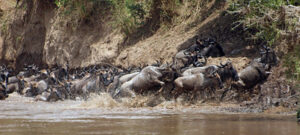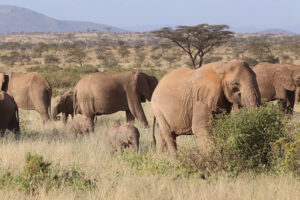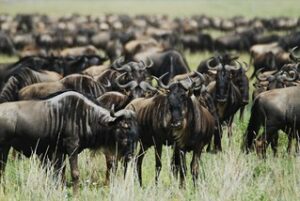The Ngorongoro Crater is a UNESCO World Heritage Site and one of Africa’s most iconic wildlife destinations, offering visitors unforgettable wildlife viewing experiences year-round. Protected by the Ngorongoro Conservation Area, Ngorongoro is the world’s largest volcanic caldera that is not lake located in northeastern Tanzania, in the Ngorongoro District, about 3-hours from Arusha.
The crater, often called Africa’s Garden of Eden provides one of the greatest safari experiences in Tanzania. Ngorongoro Crater lies under a densely wooded 600-meter volcanic cliff, and its floor is teeming with a variety of wildlife including globally threatened species and the annual Great Wildebeest Migration. Ngorongoro alone is part of this multi-use region which is also home to semi-nomadic Maasai pastoralists who practice traditional cattle grazing alongside wildlife.
The Ngorongoro Crater is a year-round safari destination. However, the timing of your visit can greatly impact your experience, as seasonal changes influence animal sightings, weather, and crowd levels. Here’s a month-by-month guide to help you plan your safari to Ngorongoro Crater at the best time;
What is the Weather Like in the Ngorongoro Crater?
The weather in the Ngorongoro Crater is warm and temperate with two rainy seasons; March to May and November to December and two dry seasons from June to October and January to February;
Rainy Seasons: November to December and March to May
This season is characterized by rainy showers and chilly days. Mornings are often cool, but the temperature rises during the day compared to the dry season. From November to December, there are brief rain showers throughout the afternoons. Cold fronts may bring cold temperatures but it seldom rains all day. Remember to carry warm gear for the early-morning game drives.
Dry Seasons: January to February and June to October
During the dry seasons, the crater rim is frequently shrouded in mist, but the crater bottom receives plenty of sunlight. January and February fall in the short dry season between the rains, though often unpredictable. During this time, expect cold conditions on morning game drives, so you’ll need warm clothes.
June to September is the long dry season characterized by cloudless, sunny skies and it tends to freeze on the rim of the crater at night. October is often a bright month in the crater; however, the brief rains may sometimes begin in late October.
Best Time to Visit Ngorongoro Crater – Month by Month
January: Short Dry Season
In January, Ngorongoro Crater is lush and green, thanks to the short rains in November and December. While some areas may still be muddy, this period offers excellent wildlife viewing, as animals are more spread out due to the abundance of water. January also marks the breeding season for the wildebeest, often known as “mass calving” which provides ecstatic sightseeing, watching the younglings come to life. Moreover, this is also a prime time for bird watchers, with migratory birds flocking to the area.
February: The Calving Season
February is the peak of the calving season in the Ngorongoro Crater. This is the best month to enjoy predator-prey interactions as lions, leopards, and hyenas set out to hunt the young wildebeests, zebras, and gazelles. This month is also an excellent time for photographers seeking dramatic wildlife interactions. However, expect moderate to high crowds in the crater, especially towards the end of the month.
March to May: The Long Rainy Season
March marks the end of the short dry season, and while the “long rains” become more frequent, Ngorongoro Crater remains a haven for wildlife. This month is one of the best months to visit the Crater for those who hate crowds and want to take advantage of discounted rates on admission fees. The lush scenery provides a stunning backdrop, especially for photographers and nature enthusiasts. The “long rains” begin in late March and last until May. However, the increase in rainfall as the month progresses could impact visibility.
April and May
April is one of the wettest months in Ngorongoro Crater. The heavy rains may result in muddy roads and limited access to some areas. However, this is also the least crowded time of year, making it an attractive option for those seeking a more secluded experience. The landscape is vibrant and green, and birdwatchers will enjoy the abundance of migratory species.
May sees the tail end of the rainy season, with rain showers gradually decreasing. During this time, the crater is still lush and vibrant, and as the rain subsides, visibility improves. Wildlife is abundant, and the limited number of visitors makes it a great time for those wanting a quieter game-viewing experience.
June: Beginning of the Long Dry Season (Peak tourism season)
June is the start of the long dry season, bringing cooler, drier weather. Wildlife concentrates around water sources, making it easier to spot various species. This is the beginning of the peak tourist season, so expect an increase in visitors as the month ends. During this month, most travelers like to combine Ngorongoro Crater with climbing Mount Kilimanjaro given the dry and cool weather conditions.
July and August: Peak Tourism Season
In July and August, Ngorongoro Crater is at its best for wildlife viewing, as animals congregate around the remaining water sources, making it easy to catch sights of animals like leopards, buffaloes, and elephants. The cooler weather and dry conditions make it an ideal time for game drives and safari tours. July and August are the most popular months to explore Ngorongoro Crater since tourism is at its peak. Expect a higher number of tourists and a high demand for lodging and permits which requires booking in advance.
September: The Dry Season Continues
September remains within the dry season, making it an excellent time for game viewing. The crater’s dry conditions offer clear visibility, and animals continue to gather around water sources. However, the crater may get rather cold at this time and crowds begin to thin out slightly toward the end of the month.
October: Transition Period
October is a transitional month in the Ngorongoro Crater as the dry season starts giving way to the short rainy season. Wildlife sightings remain excellent, although the weather turns wetter toward the end of the month. Moreover, crowds are generally lower compared to the peak tourism months.
November: Short Rainy Season
November marks the beginning of the short rainy season in the Ngorongoro Crater. During this time, the vegetation starts to turn green, creating stunning backdrops for wildlife photography. Although some rain can make roads quite slippery, this month offers a unique opportunity to see Ngorongoro’s transformation with fewer crowds. November is one of the greatest seasons for bird watching in the crater since the first migrating birds come with the rainy season.
December: Holiday Season
December brings the short rains, which enhance the crater’s lushness and attract a wide variety of animals. Early December may offer a balance of good wildlife viewing and fewer crowds since the holiday season also increases visitor numbers toward the end of the month.
popular gorilla safaris for Uganda and Rwanda
[/vc_column_text][/vc_column][/vc_row]
10 Day wildebeest and gorilla trekking safari
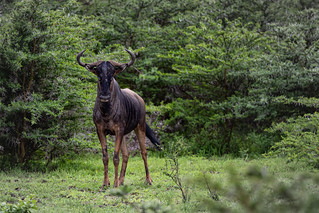
Embark on a captivating journey through the heart of East Africa as we invite you to explore the enchanting landscapes, vibrant cultures, and rich biodiversity of Rwanda and Tanzania. This meticulously crafted 10-day itinerary promises an immersive experience, seamlessly blending the awe-inspiring encounters with Rwanda’s majestic gorillas and golden monkeys
| TRIP DETAILS |
| REQUEST INFO |
10 Days Kilimanjaro and gorilla trekking safari
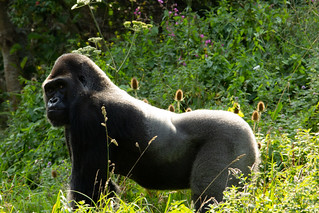
This 10 days Kilimanjaro & Gorilla safari brings you to the highest peak of the tallest mountain in Africa standing at 5895m above sea level. Mountain Kilimanjaro is the longest single-standing mountain in the world. Although there are 6 routes for hiking the mountain Kilimanjaro, which are; the Shira (Londorossi) route, Lemosho route, Machame route, Umbwe route, Maranggu route, and Rongai route.
| TRIP DETAILS |
| REQUEST INFO |
14 Day best of Rwanda and Tanzania vacation safari
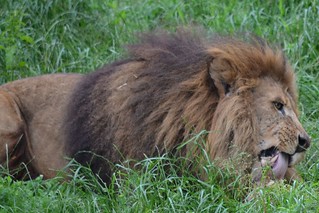
Embark on an extraordinary 14-day journey through the heart of East Africa, where the tapestry of nature unfolds in its most magnificent and untamed form. This meticulously crafted itinerary invites you to traverse three captivating countries – Rwanda, Kenya, and Tanzania – each offering a unique blend of culture, wildlife, and breathtaking landscapes.
| TRIP DETAILS |
| REQUEST INFO |


